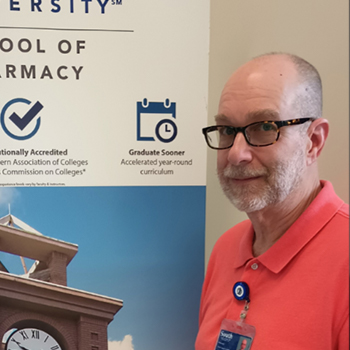RESEARCH
In HCOM, we teach our students to be the difference in health care.
We also feel a responsibility for making sure we are the difference in health communication. We strive to create a program with a strong sense of community, and we broaden that community when we invite scholars from all over the world to join in our conversations and open our eyes to the most cutting-edge research in health communication.
All of our outreach programs are open to the public, free to participate and 100% online and asynchronous:
How does HCOM help students make a difference in healthcare?
How does HCOM help students
make a difference in
healthcare?





Click here to read more questions & answers.
Click here to read more questions & answers.
Academic Research
The teaching faculty within the HCOM program continue to contribute to our understanding of how we seek, process, and disseminate health information. Below is a sampling of our most recent publications. Feel free to click the People tab to learn more about the innovative work our HCOM faculty are conducting to further our knowledge of health communication.
Health Campaigns: Underserved/Vulnerable Populations
2023 Cabral A. Bigman Health campaigns are interventions that seek to promote health by educating, persuading, or motivating action over a defined period of time for noncommercial reasons. Typically, health campaigns aim to change behaviors that undermine health, or to create or reinforce healthy behaviors. However, health campaigns can also seek to change public policies that affect health or educate or persuade people about health-related topics (e.g., increase knowledge or affect beliefs, attitudes, norms, etc.).
Health Messaging During a Pandemic: How Information Type and Individual Factors Influence Responses to COVID-19 Messages
2022 Elisabeth Bigsby and Ethan Morrow Traditional approaches to public health messaging suggest successful COVID-19 messages should communicate about the health threat and present effective protective behaviors. However, as the pandemic continues, how individual factors affect audience responses to such messages needs to be explored. We surveyed 224 U.S. residents (equal distribution among age group, education level, and gender) in a 2 (health threat information: high versus low)×2 (self-efficacy information: present versus absent)×2 (response efficacy information: present versus absent) experimental design. Variations in message information did not influence mask wearing and handwashing behavioral intentions. Instead, participant responses followed reactance theory predictions. Feelings of fear about COVID-19 and reactance proneness predicted a perceived freedom threat.
Herbert Hoover, Franklin Roosevelt, and the Candid Camera
2021 Cara A. Finnegan What came to be known as candid camera photography appeared on the scene beginning in the late 1920s, made possible by smaller, more portable cameras that were capable of producing intimate photographs of seemingly unguarded subjects. Variously called “miniature” or “mini” cameras, “hand cameras,” or “candid cameras,” these small devices allowed photographers to make images of political leaders in a whole new way. Stiff group poses illuminated by obtrusive, exploding flash power could now be replaced by close-ups of diplomats conversing in the quiet corners of meeting rooms or laughing over drinks at the hotel bar.
Mother-Adolescent Communication in Low-Income, Latino Families during Language Brokering: Examining the Theory of Resilience and Relational Load
2019 Lisa M. Guntzviller and Ningxin Wang Low-English proficiency parents often have their bilingual children translate, called language brokering. Brokering can be stressful for low-income, Latino adolescents, who are already at-risk for depression. We tested the theory of resilience and relational load (TRRL) in a new context (in 100 low-income, Latino mother-adolescent dyads who engaged in language brokering) and extended TRRL by proposing security- and threat-based behaviors and appraisals can be represented by interaction goals.
Computer-Mediated Communication and Well-Being in the Age of Social Media: A Systematic Review
2022 Andrew C. High, Erin K. Ruppel, Bree McEwan and John P. Caughlin The association between computer-mediated communication (CMC) and well-being is a complex, consequential, and hotly debated topic that has received significant attention from pundits, researchers, and the media. Conflicting research findings and fear over negative outcomes have spurred both moral panic and further research into these associations. To create a more comprehensive picture of trends, explanations, and future directions in this domain of research, we conducted a systematic meso- level review of 366 studies across 349 articles published since 2007 that report associations between CMC and well-being.
Social Support: Understanding Supportive Relationships Through Cultural Perspectives
2021 Elaine Hsieh and Eric M. Kramer An overview of the literature on social support, highlighting its multi-dimensional meanings as situated in interpersonal and social contexts. By situating the meanings of social support in cultural contexts, we acknowledge that social support is a cultural phenomenon that needs to be understood, interpreted, and enacted through its cultural norms. By adopting a normative approach to individuals’ interpretation and evaluation of social support, we will explore the challenges to identity management and illness management faced by patients and their supportive others in offering different forms of social support.
Communication Mediators of the Link Between Depressive Symptoms and Relationship Satisfaction Among Army Soldiers
2021 Leanne K. Knobloch and Erin D. Basinger We evaluated two fundamental communication processes, self-disclosure and destructive conflict management strategies, as mediators of the link between depressive symptoms and relationship satisfaction among married U.S. soldiers.
An Investigation into the Portrayal of Organ Donation on Grey’s Anatomy Seasons 1 Through 15
2023 Brian L. Quick, Lauren A. Kriss, Stephen A. Rains, Margaret Sherlock-Jones & Minjoung Jang The current project sought to extend prior research examining organ donation portrayals on Grey’s Anatomy by examining the first fifteen seasons. Guided by the health belief model, content analysis revealed more attention was given to benefits of donation than barriers. Contrary to previous research, more attention was given to refuting rather than promoting commonly cited myths. The results also address attention to the health threat as well as Grey’s Anatomy’s representation of self-efficacy in registering to be an organ donor. Finally, proportion tests revealed significant differences between the types of organs transplanted on Grey’s Anatomy compared to organs transplanted in the United States. The results are discussed with an emphasis on portrayal trends throughout Season 1 through 15 as well as the theoretical and practical implications of our findings.
Women’s Experiences of Health-Related Communicative Disenfranchisement
2022 Charee M. Thompson, Sara Babu & Shana Makos Women’s inequitable healthcare experiences are epistemic injustices by which women are discredited and harmed in their position as knowers of their health and their bodies. Drawing on the theory of communicative disenfranchisement (TCD), we sought to amplify voices of women experiencing communicative disenfranchisement (CD) and to unify their stories according to theoretical premises, namely, attention to power, material conditions, discourse, identities and relationships, and process.